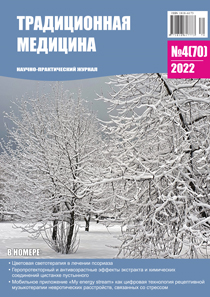Research of aerial parts of black cumin (Nigella sativa L.), growing in Tajikistan
DOI:
https://doi.org/10.54296/18186173_2022_4_10Keywords:
Black cumin (Nigella sativa L.), Abu Ali ibn Sino, Avicenna, Canon of Medicine, «mizaj» (nature), micro- and macroelementsAbstract
For the first time, the content of some of the most important macro- and micro-elements in the aerial part of black cumin Nigella sativa L. was determined. In water and alcohol extracts, the content of some alkali and alkaline earth metals, which impart «alkalinizing» properties to the plant, was established (the authors did not set the task to determining the complete and accurate quantitative elemental composition). In this connection, the nigella sativa is classified as a plant with a “hot mizaj”, in accordance with the concept of Avicenna about the “hot mizaj” of plants containing alkaline and alkaline earth elements, which he describes in “The Canon of Medicine”.
References
Абу Али ибн Сина (Авиценна). Сочинения. Т. 12–13. Канон врачебной науки / Абу Али ибн Сина. – Книга первая и вторая. – Душанбе: Дониш, 2012. – 958 с.
Molecular approach to determine the hot and cold temperaments in plants according Avicenna concepts, the role of magnesium / M. Sharofova, I. Aldybiat, Sh. Sagdieva [et al.] // Vestnik Avitsenny [Avicenna Bulletin]. – 2018. – 20(4). – P.421–6. Available from: http:// dx.doi.org/10.25005/2074-0581-2018-20-4-421-426.
Comparative Studies on Polyphenolic Composition, Antioxidant and Diuretic Effects of Nigella sativa L. (Black Cumin) and Nigella damascene L. (Lady-in-a-Mist) Seeds / C.C.Toma, N.K.Olah, L.Vlase [et al.] // Molecules. – 2015. – V.20(6). – P.9560–9574.doi: 10. 3390/molecules20069560.
Nadithe, L.R. Experimental evaluation of diuretic property of Nigella sativa oil in albino rats / L.R. Nadithe, P. Chinnam, M. Mohsin // Indian J. Pharmacol. – 2013. – №45. – Р.59.
Metabolomics driven analysis of six Nigella species seeds via UPLC-qTOF-MS and GC-MS coupled to chemometrics / M.A. Farag, H.A. Gad, A.G. Heiss [et al.] // Food Chem. – 2014. – №151. – Р.333–342.
Comparison of seed oil composition of Nigella sativa L. and N. damascene L. during seed maturation stages / I. Telci, A. Sahin-Yaglioglu, F. Eser [et al.] // J. Am. Oil. Chem. Soc. – 2014. – №91. – Р.1723–1729.
Исследование антидиабетических свойств надземных частей чернушки посевной (Nigella sativa L.) / М.У. Шарофова, Ю.Н., Нуралиев, П.Д. Шабанов [и др.] // Вопросы биологической, медицинской и фармацевтической химии. – 2018. – 21(10). – С.112–118. https://doi.org/10.29296/25877313-2018-10-21.
Кароматов, И.Д. Чернушка посевная и мочеполовая система / И.Д. Кароматов, Н.Ш. Акрамова // Электронный научный журнал «Биология и интегративная медицина». – 2019. – №2 – февраль (30). – С.125–134.
Рудь, Н.К. Основные результаты фитохимического и фармакологического исследования чернушки посевной / Н.К. Рудь, А.М. Сампиев, Н.А. Давитавян // Научные ведомости. Серия Медицина. Фармация. – 2013. – №25(168). – Выпуск 24. – С.207–212.
ОФС.1.4.1.0018.15. Настои и отвары. ГФ РФ ХIV изд. Электронный ресурс. //https://pharmacopoeia.ru/ofs-1-4-1-0018-15-nastoi-i-otvary/.
Никитина, А.С. Элементный состав побегов розмарина лекарственного (Rosmarinus officinalis L.), интродуцированного в ботаническом саду Пятигорского медико-фармацевтического института / А.С. Никитина, З. М. Тохсырова, О.И. Попова //Фармация и фармакология. – 2017. – Т.5. – №6. – С.581–588.
Dose-response relationship between dietary magnesium intake and risk of type 2 diabetes mellitus: A systematic review and meta-regression analysis of prospective cohort studies / X. Fang, H. Han, M. Li [et al.] // Nutrients. – 2016. – 8(11). – P.739.
Downloads
Published
How to Cite
Issue
Section
License
Reproduction of any materials without the written permission of the publisher is prohibited.
The responsibility for the accuracy of the information contained in articles and advertisements are the authors and advertisers.






